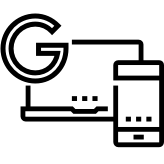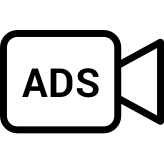
Hire Google PPC Agency
Empower Your Online Presence: Ascend to Success with PPC Google!
Experience the power of targeted marketing, expand your brand's reach, and achieve remarkable business growth. Seize the opportunity to employ Google Ads to its fullest prospect and witness your business soar to new heights.
Drive Sales Growth and Expand Your Business with the Power of Google PPC Ads
As a visionary business owner, your aspirations extend beyond merely having a website. You strive for a steady influx of new customers, an influx of phone calls that never ceases, a constant stream of sign-ups, a surge in purchases, and a remarkable conversion rate for lead forms. To turn these ambitions into reality, you need a seasoned expert who can deftly manage your Google PPC Ads campaigns, someone who intimately understands your market and can deliver an impressive volume of traffic composed of precisely the right customers, all while ensuring an unbeatable return on investment (ROI).
Conquer the Digital Frontier: Dominating the Digital Landscape with Google PPC Ads
With Google PPC Ads, your advertisements will command center stage in search results, captivating your desired audience and leaving an indelible impression. Through a harmonious blend of creativity and professionalism, our tailored Google Click Ads strategies will thrust your business into the spotlight, generating a steady flow of qualified leads and maximizing conversions.
Prepare to be awestruck by the sheer potency of targeted marketing and witness firsthand how Google Ads becomes your steadfast ally, accelerating your business growth and granting you the key to untapped opportunities. Enfold the power that awaits you and grasp the boundless potential of Google Ads, where your brand's horizons expand, and extraordinary
success becomes the new norm. Trust professional expertise to optimize your online Google pay-per-click advertising campaigns, attracting precisely the audience you seek and guaranteeing an ROI that will leave you astounded. Join us as we set forth on this transformative path toward triumph and prosperity.
The Hidden Toll of Inefficient PPC Google Management: Safeguard Your Resources from Missed Opportunities
The implications of overlooking the significance of proficient pay-per-click (PPC) Google advertising can swiftly lead to substantial financial losses. It is common for individuals needing more experience to require assistance fully harnessing the immense potential of Google Ads, leaving valuable opportunities unexplored.
We have firsthand knowledge of the detrimental effects that arise, ranging from missed prospects to wasteful depletion of advertising budgets. Engaging in self-managed PPC campaigns carries inherent risks that outweigh the potential benefits.
Mastering Google Ads PPC: Targeted Traffic and Cost Control Made Simple
Google Ads, formerly Google AdWords, equips business owners with powerful tools to drive targeted website visitors through a pay-per-click (PPC) model. With this approach, you pay for search queries that generate traffic to your site.
The core benefit of pay-per-click lies in its versatility, offering numerous ways to target prospects effectively. You have complete control over your costs, allowing you to optimize your advertising strategy and avoid draining your resources.
At Saffron Edge, we specialize in Google Ads PPC management, providing comprehensive support in the following areas:

Audience Profiling
Analyzing your target audience and their geographic locations to ensure precise targeting.
Keyword Research
Conducting thorough and meticulous research to uncover the most relevant and impactful keywords that align with your products or services.
Strategic Advertising Development:
Defining clear advertising goals, establishing realistic budgets, and setting performance benchmarks to drive effective campaign outcomes.
Tailored Advertisements:
Crafting compelling ad copy and visually appealing graphics that resonate with your company's unique brand identity and offerings.
Efficient Campaign Management:
Streamlining the management and monitoring of your Google pay-per-click advertising campaigns to maximize their effectiveness.
Optimization Strategies:
Implementing advanced techniques such as bid optimization, ad copy split testing, and conversion rate optimization to improve campaign performance continuously.
Comprehensive Monthly Reports:
Providing insightful reports that offer a detailed analysis of your campaign's performance, enabling you to gauge its ROI and make informed decisions.Exploring the Versatility of Google Ad PPC Campaigns
Explore the extensive array of pay-per-click Google campaigns at your disposal. If you require further clarification on the most suitable option, take comfort in knowing that our team is ready to offer expert guidance and unflagging support.

Search Campaigns
Connect with potential customers searching for your products or services on Google and partner sites. Utilize targeted location and keyword strategies to ensure that you reach and engage with prospects who genuinely need what you offer.
Display Campaigns
Utilize various targeting options to showcase your ads on relevant websites, niche-specific platforms, and the Google Search Network. Increase brand visibility and reach a wider audience through banner ads, Google shopping ads, image ads, mobile app campaigns, and video ads.
Remarketing Campaigns
Re-engage with past visitors of your website by displaying tailored ads on the Google Display Network. Benefit from warm leads who have already shown interest in your business and increase the likelihood of conversion. Stay top-of-mind as they continue their online journey.Saffron Edge: EMPOWERING YOUR SUCCESS!
Liberate yourself from mediocre PPC Google management and entrust our team of seasoned virtuosos to unbind the true possibility of your digital advertising. From crafting compelling ad copy to optimizing campaigns for maximum conversions, we are dedicated to propelling you toward unparalleled heights of success. Whether you aim to skyrocket sales, amplify conversions, or extract maximum value from your advertising investments, we stand as your unwavering shield. Let us rewrite the rules of your advertising game and revel in the brilliance of exceptional results.
Enhance Google Ads Performance with our Expert PPC Campaign Management Strategy
Our team of PPC specialists possesses the expertise needed to optimize your Google Ads and drive success for your business. Through a systematic and indelible process, we ensure your digital ad campaigns are precisely targeted, well-budgeted, feature persuasive ad copy, and continuously monitor performance. With our Google Ads management strategy, we provide you with the essential tools and tactics to achieve your business objectives effectively.
- Pinpoint Precision:
We laser-focus your Google Ads, honing in on the exact audience that holds the key to your success.
- Financial Fortitude:
We sculpt a budget that aligns seamlessly with your objectives, ensuring every penny is invested wisely.
- Artistry in Ad Copy:
Our creative geniuses craft Google Ads, not just words on a screen but magnetic masterpieces that captivate and convert.
- Performance Symphony:
We conduct an intricate symphony of tracking and analysis, constantly monitoring your Google Ads campaign performance to extract actionable insights.
- Adaptive Brilliance:
Armed with data-driven wisdom, we make swift and strategic changes, sculpting your campaign for optimal results, flexing, and evolving as needed.
Witness the transformative power of our Google PPC Ads management strategy as we unlock the door to unprecedented success, guiding you toward your business aspirations with relentless expertise.
An In-depth Exploration of Our PPC Process

Audience Profiling: Delving Deep into Insights
We are Google Certified Partners, and our experts have the required competence to design successful paid search, display ads, and remarketing campaigns.

Strategic Planning: Compelling Ads that Ignite Results
Groundwork: Equipped with a robust strategy, our accomplished copywriters and pay-per-click specialists spring into action, crafting captivating ads that effortlessly capture attention and generate clicks. We optimize for exceptional conversion rates through meticulous A/B testing of various iterations, consistently fine-tuning and enhancing your campaigns to stay one step ahead of the competition.

Impeccable Execution: Unbirdle the Power of Compelling Ads
Creation: With our strategy firmly in place, our skilled copywriters and pay-per-click experts deploy their expertise to create visually striking ads that command attention and drive clicks. We constantly refine and optimize your campaigns to achieve unprecedented conversion rates, maintaining a competitive edge in the ever-evolving digital landscape.

Performance Analysis: Transparent Reporting, Actionable Insights
Outcome: Our commitment extends beyond the launch of your ads. We diligently monitor and analyze your campaigns, presenting transparent and comprehensive reports that elucidate your performance metrics and offer actionable insights to optimize your results further. Continually striving to enhance your ROI, our transparent reporting ensures complete awareness of how your advertising budget is allocated, empowering informed decision-making at every turn.
Optimizing Your Google Ads Success: Keeping Your Campaigns on Track
- Targeted Ad Campaigns:
Our team expertly optimizes keywords and precision-targets your audience, ensuring your ads reach receptive viewers and significantly boosting your conversion potential.
- Budget Optimization
Take control of your spending and achieve a positive ROI with our expert guidance in establishing a reasonable budget tailored to your business objectives.
- Compelling Ad Copy:
Our talented team crafts persuasive ad copy that resonates with your target audience, driving higher engagement and maximizing click-through rates for your Google Ads.
- Influence Buyer Decisions
90% of buyers report that online ads influence their buying decisions.
- Performance Tracking:
With seamless Google Analytics integration, we diligently monitor your campaign's performance. We identify successful placements, track key metrics, and make data-driven adjustments to optimize your results continuously.
- Celebrate Achievements
Upon reaching your goals, we wholeheartedly encourage celebration as a testament to our pragmatic approach. Your success becomes our inspiration, fueling continued growth and exceeding expectations.
Saffron Edge: The Unconventional Creative Force
At Saffron Edge, we transcend the traditional boundaries of a mere media buying agency. We seamlessly integrate ourselves as an extension of your in-house advertising team, employing a full-funnel approach that leaves no stone unturned. Our dynamic strategy is rooted in omnichannel mastery and hyper-personalization, nurturing your business to flourish across every stage of the customer journey – from enticing and converting prospects to fostering unwavering loyalty. We are not just a team but a collective of visionary artists, strategic planners, ingenious web designers, and gifted developers. Together, we undertake a quest to forge digital experiences that etch themselves deep into the memories of those who encounter them. We don't just envision your story; we wholeheartedly embrace it and breathe life into every pixel and line of code, creating an immersive narrative that resonates and captivates.
Finding the Perfect Agency To Meet Your Data-driven Needs Is Crucial for Achieving Optimal Results. Let’s Explore if Our Expertise Aligns With Your Requirements.
Frequently asked questions
What Are Paid Search Services?
Paid search services refer to professional marketing services that help businesses create and manage paid search campaigns to increase visibility and drive traffic to their websites or landing pages.
How Can Paid Search Services Benefit My Business?
Paid search services can benefit your business by targeting relevant keywords and placing your ads in front of your target audience. This increases the chances of attracting qualified leads and driving conversions, ultimately helping you achieve your marketing goals.
What Is Paid Search Management Service?
Paid search management service involves optimizing and monitoring your paid search campaigns. It includes keyword research, ad creation, bid management, performance tracking, and continuous optimization to maximize the return on your advertising investment.
Why Should I Consider Outsourcing Paid Search Management?
Outsourcing paid search management allows you to leverage the expertise of professionals specializing in optimizing and managing paid search campaigns. This can save you time, resources and ensure that your campaigns are handled by experienced professionals who can deliver better results.
How Does Saffron Edge Ensure the Success of My Paid Search Campaigns?
Saffron Edge employs a data-driven approach, leveraging industry best practices and advanced tools to optimize your paid search campaigns. We continually monitor performance, make data-driven adjustments, and provide transparent reporting to ensure the success and effectiveness of your campaigns.
Can Saffron Edge Help Me With My Paid Search Campaign Setup?
Absolutely! Saffron Edge's team of experts can assist you with setting up your paid search campaigns. We will conduct thorough keyword research, create compelling ad copy, set up targeting parameters, and ensure proper tracking implementation for accurate campaign measurement.
How Do Paid Search Campaigns Contribute to My Online Advertising Strategy?
Paid search campaigns play a crucial role in your online advertising strategy by capturing the attention of users actively searching for products or services related to your business. They complement other marketing efforts, increase brand visibility, and drive targeted traffic to your website.
Can Saffron Edge Handle Large-Scale Paid Search Campaigns?
Yes, Saffron Edge has experience in managing campaigns of various sizes, including large-scale paid search campaigns. Our team of experts is equipped to handle the complexities of extensive campaigns and optimize them for maximum performance and ROI.
What Sets Saffron Edge’s Paid Search Services Apart From Others?
Saffron Edge's paid search services stand out due to their expertise, industry knowledge, and commitment to delivering exceptional results. We combine strategic planning, creative ad copy, and continuous optimization with helping businesses maximize their paid search investment and achieve their marketing objectives.
How Can Paid Search Campaigns Help Increase My Website’s Visibility on Search Engines?
Paid search campaigns can increase your website's visibility on search engines by placing your ads at the top or prominently on search engine results pages (SERPs). When users search for keywords relevant to your business, your ads have the potential to appear above organic search results, ensuring greater visibility and attracting more clicks from potential customers.
Testimonials
What our customers say about us




















